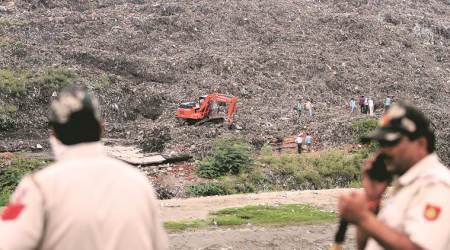 The Ghazipur landfill that crashed last week was more than 50 metres high — almost as high as a 15-storey building or two-thirds the height of the Qutub Minar. (File)
The Ghazipur landfill that crashed last week was more than 50 metres high — almost as high as a 15-storey building or two-thirds the height of the Qutub Minar. (File)
On Monday, the National Green Tribunal pulled up the Delhi government and the East Delhi Municipal Corporation (EDMC) over the Ghazipur landfill collapse that killed two people on September 1. The EDMC told the green court that it had moved a plea seeking allotment of land to develop landfills to handle municipal solid waste. The municipal agency’s response does not inspire confidence. Delhi generates more than 10,000 tonnes of garbage every day, most of which stacks up in ugly hills, posing environmental and public-safety hazards. Finding new landfills would mean merely relocating the problem.
The Ghazipur landfill that crashed last week was more than 50 metres high — almost as high as a 15-storey building or two-thirds the height of the Qutub Minar. Another landfill at Bhalswa in northwest Delhi is as high — it has been shut down in the aftermath of the Ghazipur mishap. The 33-year-old dump yard at Ghazipur should have been shut down years ago, or at least immediately after the Solid Waste Management Rules, 2016, came into force. The rules stipulate that a landfill should not be more than 25 years old. Delhi’s two other landfills, at Okhla and Narela-Bhawana, are also past their saturation point. But the problem is not restricted to Delhi. Dump sites in most Indian cities are handling much more waste than they can hold. Last year, the then environment minister Prakash Javadekar said that the country generates more than 60 million tonnes of garbage every year — more than double the amount generated at the beginning of the century. Most urban agencies are at sea when it comes to dealing with such large amounts of waste. Mumbai’s landfills, for example, are stretched beyond their limits. Last year, large parts of the city were engulfed in smog after the 55-metre high Deonar dump caught fire.
It would be wrong to have an one-size-fits-all solution for the waste problems of urban India. But it is well-established that garbage management becomes a difficult proposition when recyclables, organic wastes and toxic wastes are all dumped together. Segregating waste at source holds the key to effective waste management. Some Indian cities are working out mechanisms for such decentralised systems. The Mysuru City Corporation, for example, has focused on segregation of trash at source, door-to-door collection, recycling and involvement of non-profits and educational institutions in public awareness campaigns. Similar initiatives are also underway in Panaji and Alappuzha. Delhi, Mumbai — most Indian cities — could begin by emulating these cities in getting their basics right.

